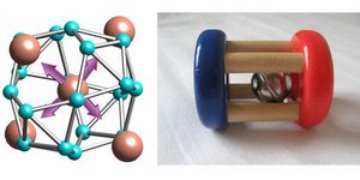Dec. 21, 2007 Research Highlight Physics / Astronomy
Rattling the cages of superconductivity
The strong rattling motion of potassium in its atomic cage strongly affects the superconducting state
 Figure 1: Superconducting ‘rattlers’. The crystal structure of KOs2O6 consists of a cage that allows for a strong oscillatory motion of the potassium (K) ion (left). This motion is similar to that made by a baby rattle (right). © Physical Review B/The American Physical Society/76/014523 (2007) (left)
Figure 1: Superconducting ‘rattlers’. The crystal structure of KOs2O6 consists of a cage that allows for a strong oscillatory motion of the potassium (K) ion (left). This motion is similar to that made by a baby rattle (right). © Physical Review B/The American Physical Society/76/014523 (2007) (left)
A strong interplay between the oscillations of a potassium ion in the crystal structure of KOs2O6 and this material’s superconductive properties has been discovered by a collaboration of researchers from the University of Tokyo, the Tokyo University of Science and RIKEN’s SPring-8 Center in Harima.
KOs2O6 is one of a number of compounds with a crystal structure that contains cage-like motifs (Fig. 1). The relatively small size of the potassium ion compared to the cage allows for strong oscillating or ‘rattling’ motions of the ion within the cage. Materials closely related to KOs2O6 are RbOs2O6 and CsOs2O6. Of these three, KOs2O6 is the compound with the strongest rattling motion. Importantly, all three ‘rattler’ compounds show superconductivity, which is a rare combination.
This rarity makes these materials very interesting systems for physicists to study the influence of the rattling motion on the superconducting state. In principle, a relation between these two properties is not entirely unexpected, as superconductivity is facilitated by the interaction of superconducting electrons with the atoms of the crystal lattice.
Unfortunately, however, superconductivity in these rattler compounds is relatively weak such that the expected influence of the rattling on the electronic states of the material is very small and observable only at low temperatures. Consequently, detailed investigation into the correlation of the rattling motion and superconducting properties has been a formidable task. As such, the researchers first had to develop a laser spectrometer to probe the materials’ electronic states that, according to Ashish Chainani from the RIKEN team, “has the highest energy resolution and the lowest operating temperature in the world.”
In experiments with this advanced spectrometer, the researchers have found1 that the onset of the rattling motion clearly affects the superconducting properties of KOs2O6. In fact, when compared to the expected values obtained from the standard theoretical framework for superconductors, superconductivity appears to be enhanced by the rattling motion.
Intriguingly, of the three rattler compounds, KOs2O6 is not only the material that shows the most stable superconductivity, but has also the strongest rattling motion. So does this rattling not only influence, but also strengthen superconductivity? “It is probably too early to answer this question—but we are planning to do further experiments in this direction,” comments Chainani. The investigation into this relation certainly promises to shed light on intriguing aspects of our fundamental understanding of superconductivity.
References
- 1. Shimojima, T., Shibata, Y., Ishikaza, K., Kiss, T., Chainani, A., Yokoya, T., Togashi, T., Wang, X.-Y., Chen, C.T., Watanabe, S., Yamaura, J., Yonezawa, S., Muraoka, Y., Hiroi, Z., Saitoh, T. & Shin, S. Interplay of superconductivity and rattling phenomena in β-pyrochlore KOs2O6 studied by photoemission spectroscopy. Physical Review Letters 99, 117003 (2007). doi: 10.1103/PhysRevLett.99.117003
